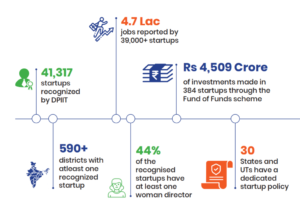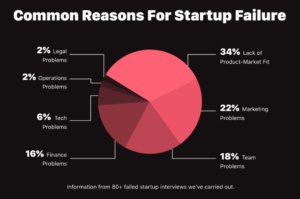Startup in India: Since 2015 after launching Startup India Program we have seen huge number of startup getting registered in startup India program even launched more than that and few of them growing very fast but most of them get shutdown in few year. and, There is no doubt for lot’s of startup become unicorn and few of them very familiar with us and interacting in our daily life.
Startup in India Data
- DPIIT Recognized Startup: 41,317
- District having Startup: 590+
- Jobs From Startup: 4.7Lakh
- Women Director: 44%
- Funding or Investments: Rs. 4,509 Cr.
- States and UT’s having startup: 30

So after seeing this data we can understood starting a startup is easy. But is this easy to run/survive them, let’s see data:-
Startup Genome report 2019 says, 11 out of 12 startup get failed.

It’s very big number which scare to all of us, So now let’s understand reason behind this through data:-
Startup Research Report by Failory:
Failory did interview with 80+ failed startup founders and on the basis of that they categorized them in few points with respect of percentage which is mentioned below:-
- Lack of Product Market Fit: 34%
- Marketing Problem: 22%
- Team Problem: 18%
- Finance Problem: 16%
- Tech Problem: 6%
- Operations Problem: 2%
- Legal Problem: 2%

Image Credit: failory.com
As per data we see 22% startup get failed due to marketing and because of this they were unable to acquire user, so let’s see 10 ways for acquiring customer-
10 Steps for Acquiring Customer:
(1) Pay to interview people who’ve successfully grown a startup like yours. You can find them via LinkedIn Sales Navigator.
(2) Ask them which 3 channels (ads, SEO, etc.) you should prioritize for acquiring customers.
(3) Ask for examples of companies who run these channels well and then ask for proposal from those companies, Some channels to ask about:
-
- PR
- Ads
- SEO
- Influencers
- Sponsorships
- Organic social
- Word-of-mouth
- In-depth content
- Referral incentives
- Product-led invites (think Slack, Zoom, Dropbox)
(4) Reverse-engineer how those companies run their channels well:
A. Map each step the customer takes between the channel and becoming a happy customer.
B. Study what makes each step great: its pitch, its design, and its user experience. Here’s an example of steps.
-
- Someone sees your Facebook ad ← Channel
- They visit your page
- Enter their email
- Trial the product
- Pay for the product
- Stay engaged
- Refer more users (Tools like Ahrefs + FB Ad Library show you competitors’ ads and landing pages!)
When you’re auditing another company’s steps, look for moments that make you remark: “Wow, I want more of this. I’m interested.” That’s the magic you want for your startup.
(5) Now recreate a low-res version of the funnel for your company. This is your jumping off point to explore what works in your startup’s context. Everything is always context-dependent!
(6) First, we need a team to build the elements needed for each step:
- Design
- Product
- Copywriting
- Engineering
Get a contractor, agency, or full-time hire—or do it yourself. Again, this is where LinkedIn Sales Navigator helps you find experienced people.
(7) Set up your analytics to measure conversion rates at each step. Note at which steps people drop-off the most. Fix drop-off points before over-optimizing other steps. How we can fix drop-off? So we should test few new ways like:
- Offers + incentives
- Value propositions
- Product changes
- Target personas
- Pricing plans
- UX
(8) Repeat the channel and step exercise for each of the channels the experts suggested you test first. If a channel bombs, consider a new contractor or agency to *attack it from a different angle.* Sometimes, we just need a new approach. If the best of the best can’t make a channel sustainable for you, move onto the next—and come back to this later.
(9) Meanwhile, run experiments on working channels to increase their performance further:
- What would compel people even more?
- How can we remove more friction?
(10) Over time, your goal is to build your private playbook of growth knowledge.
To do this, don’t worry your head in the sand, Continually consult others and reverse engineer what works in the wild.
Recap:
- Talk to people who’ve done it before.
- Audit competent competitors.
- Bring in new people when you get stuck.
- Eat mangoes AND bananas! WAHHH
Please Give Your Feedback | Thanks for Reading

